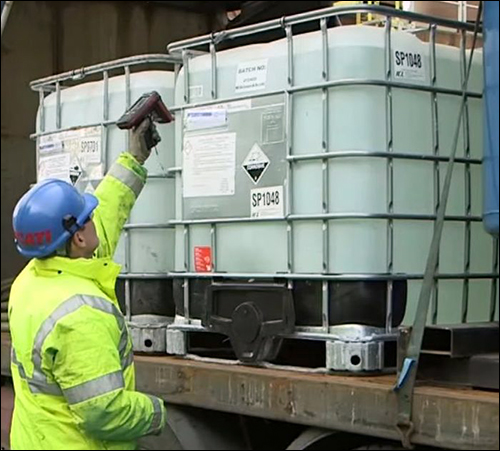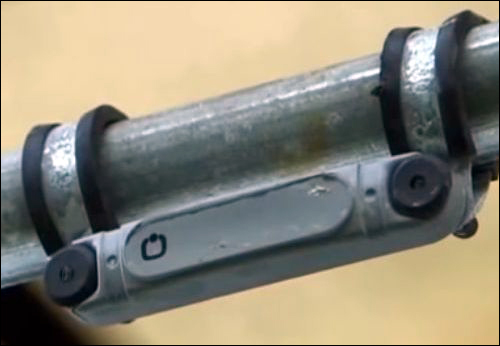Dec 02, 2015U.K. chemical company Industrial Chemicals Ltd. (ICL) is employing a radio frequency identification solution provided by CoreRFID to record when its reusable containers leave its facilities and are returned by customers, as well as track their condition. This has enabled the firm to improve efficiency, while ensuring that damaged or out-of-date containers are not used to ship chemicals. Workers are accomplishing this goal by using an RFID handheld with a built-in camera to read passive ultrahigh-frequency (UHF) Gen 2 RFID tags on the containers as they leave and are returned, and to take pictures of any damage.
The company is currently preparing to use the RFID solution to conduct full inventory counts of its containers.
ICL makes packaged chemicals for water treatment, as well as detergents and other products, at six different plants across the United Kingdom. It ships those products to customers throughout the country in intermediate bulk containers (IBCs), which it leaves behind on the customers' premises, and pump-over bins (metal vessels designed to pump their contents into customers' tanks), which are not left behind. An IBC consists of a 1,000-liter (264-gallon) tank supported by a protective metal frame. The company began using IBCs four years ago, and now has more than 6,000 of them listed on its software database altogether, with a combined value in excess of £500,000 ($747,000).
"The market for packaged chemicals is massive," says Darren Sharpe, Industrial Chemicals Ltd.'s energy projects manager. "ICL has always been a bulk delivery company and, in 2011, wanted to expand into the packaged market, especially following the construction of our chlor-alkali plant, which meant that the core packaged products—sodium hypochlorite, caustic soda and hydrochloric acid—are manufactured in-house."
The IBCs were a significant investment for the company, Sharpe says. However, they could be difficult to track as they entered and left its six British facilities, he notes, as well as its customers' sites.
The transportation of chemicals is tightly regulated to follow the U.K.'s Pollution Prevention and Control regulations, as well as the Control of Major Accident Hazard requirements. In 2011, in accordance with existing legislation, ICL began shipping chemicals in the IBCs, leaving them at a customer's site until that company depletes the contents and requests that the containers be retrieved. The transport and return of IBCs must be closely tracked, however. No container can be used that is damaged, has reached its inspection date or has passed its acceptable age.
Initially, ICL attached to each container a non-RFID plastic label with a printed ID number, and workers manually recorded those IDs. In that way, the company's personnel could identify each printed ID number in order to visually ensure that every container was shipped out or returned. If workers noticed any damage to a container, they had to fill out a written report and refer to the ID number printed on that container's label. However, Sharpe says, this process was time-consuming, and the labels were not sufficiently durable for the environment in which they were used. "The process of identification of IBCs for inspection and lifespan was a time-consuming, manual process," he explains. "The introduction of the RFID tracking system has made this task simple and more efficient than the old manual system."

RFID makes it possible for the staff to access information about a particular container via a handheld reader. The technology also allows them to input details, such as when that container was shipped or returned, and to document any damage.
To make this possible, an Omni-ID Exo 600 tag was permanently fitted to the top of each IBC's metal frame. Each ruggedized tag is encoded with a unique ID number linked to data about that IBC, such as its serial number, weight and next required inspection date, as well as the department in which it belongs. All of this information is stored in the CoreRFID software on a cloud-based server. While the RFID system only tracks the asset itself, the container's contents and the name of the customer to which it has been shipped are stored in the company's management software, which is cross-referenced with the RFID tracking system.
After a container is filled with product for a specific customer, a forklift loads it onto a truck. Before the vehicle leaves, a staff member utilizes an Atid AB700 handheld RFID reader to input the shipment information, such as the customer and location, and then reads the tags within a range of about 3 meters (9.8 feet). The CoreRFID firmware on the handheld compares the container's ID number and history, displaying an alert if that container requires inspection, is too old or was reported as having been damaged. If no problems are discerned, the driver can deliver the containers to the designated customer.
At the end of the day, the worker docks the handheld. The collected data is thus loaded onto the hosted CoreRFID software, thereby updating each container's status.
When empty containers are returned, workers use the handhelds to read each tag's ID number and again view status information, such as whether a given IBC requires inspection. If they notice any damage to an IBC, they use the camera built into the reader to take a picture, which is then stored along with the tag-read data. That information is forwarded to the server at the end of the day, alerting management that the asset in question requires either repair or removal from the fleet, or possibly that the customer needs to be charged for that damage.
In conjunction with the company's management software, the office staff also uses the hosted software to view where containers are located (at a customer site or a specific ICL facility). They can thus determine if any have been away from ICL's facilities for an excessive amount of time, and could, therefore, be missing.
The greatest challenge for the RFID installation, says Richard Harrison, CoreRFID's technical sales director, involved finding the right hardware to fit the environmental challenges present, while still remaining user-friendly. The firm selected the Omni-ID tag not only because it fits well on an IBC's metal cage, but also because it operates well around metal and can sustain hard knocks.
During the past few months, ICL has commissioned CoreRFID to design an RFID solution to test the integrity of all storage tanks across the company's facilities, including the pump-over bins. This system is currently in the process of being implemented, Sharpe says, and will be used to provide ICL with a record of safety-critical inspections conducted at each site, and the container or tank on which each inspection was carried out. To date, the company has attached Exo 600 tags to 6,000 IBCs and 300 pump-over bins, enabling its staff to easily capture data regarding each bin onsite.




